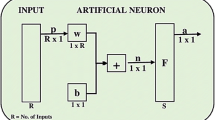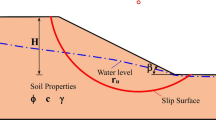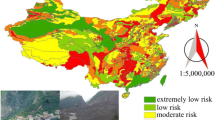Abstract
This paper presents slope stability evaluation and prediction with the approach of a fast robust neural network named the extreme learning machine (ELM). The circular failure mechanism of a slope is formulated based on its material, geometrical and environmental parameters such as the unit weight, the cohesion, the internal friction angle, the slope inclination, slope height and the pore water ratio. The ELM is proposed to evaluate the stability of slopes subjected to potential circular failures by means of prediction of the factor of safety (FS). Substantial slope cases collected worldwide are utilized to illustrate and assess the capability and predictability of the ELM on slope stability analysis. Based on the mean absolute percentage errors and the correlation coefficients between the original and predicted FS values, comparisons are demonstrated between the ELM and the generalized regression neural network (GRNN) as well as the prediction models generated from the genetic algorithms. Moreover, sensitivity analysis of the slope parameters and the ELM model parameters is carried out based on the two utilized evaluation functions. The time expense of the ELM on slope stability analysis is also investigated. The results prove that the ELM is advantageous to the GRNN and the genetic algorithm based models in the analysis of slope stability. Hence, the ELM can be a promising technique for approaching the problems in geotechnical engineering.














Similar content being viewed by others
References
Abbas D, Ataeib M, Sereshki F (2011) Assessment of rock slope stability using the Fuzzy Slope Mass Rating (FSMR) system. Appl Soft Comput 11(8):4465–4473
Bye A, Bell F (2001) Stability assessment and slope design at Sandsloot open pit, South Africa. Int J Rock Mech Min Sci 38(3):449–466
Chen WF, Snitbhan N (1975) On slip surface and slope stability analysis. Soils Found 15(3):41–49
Chen C, Xiao Z, Zhang G (2011) Stability assessment model for epimetamorphic rock slopes based on adaptive neuro-fuzzy inference system. Electron J Geotech Eng 16 (A):93–107
Choobbasti AJ, Farrokhzad F, Barari A (2009) Prediction of slope stability using artificial neural network (case study: noabad, Mazandaran, Iran). Arab J Geosci 2(4):311–319
Das S, Biswal R, Sivakugan N, Das B (2011) Classification of slopes and prediction of factor of safety using differential evolution neural networks. Environ Earth Sci 64(1):201–210
Erzin Y, Cetin T (2013) The prediction of the critical factor of safety of homogeneous finite slopes using neural networks and multiple regressions. Comput Geosci 51:305–313
Ferentinou MD, Sakellariou MG (2007) Computational intelligence tools for the prediction of slope performance. Comput Geotech 34(5):362–384
Gitirana Jr G, Santos MA, Fredlund MD (2008) Three-dimensional slope stability model using finite element stress analysis. In: Paper presented at the GeoCongress 2008: geosustainability and geohazard mitigation, New Orleans, LA, March 2008
Hoek E, Bray JW (1981) Rock slope engineering. Institute of Mining and Metallurgy, London
Huang G-B, Zhu Q-Y, Siew C-K (2006) Extreme learning machine: theory and applications. Neurocomputing 70(1–3):489–501
Huang GB, Zhou H, Ding X, Zhang R (2012) Extreme learning machine for regression and multiclass classification. IEEE Trans Syst Man Cybern Part B Cybern 42(2):513–529. doi:10.1109/TSMCB.2011.2168604
Janbu N (1973) Slope stability computations in embankment Dam Engineering. In:Paper presented at the Embankment-Dam Engineering, Casagrande vol pp 47–86
Jhanwar J (2012) A classification system for the slope stability assessment of opencast coal mines in Central India. Rock Mech Rock Eng 45(4):631–637
Johari A, Fazeli A, Javadi AA (2013) An investigation into application of jointly distributed random variables method in reliability assessment of rock slope stability. Comput Geotech 47:42–47
Kaunda R, Chase R, Kehew A, Kaugars K, Selegean J (2010) Neural network modeling applications in active slope stability problems. Environ Earth Sci 60(7):1545–1558. doi:10.1007/s12665-009-0290-3
Khandelwal M, Singh TN (2011) Predicting elastic properties of schistose rocks from unconfined strength using intelligent approach. Arab J Geosci 4(3–4):435–442
Kveldsvik V, Einstein HH, Nilsen B, Blikra LH (2009) Numerical analysis of the 650,000 m 2 Åknes rock slope based on measured displacements and geotechnical data. Rock Mech Rock Eng 42(5):689–728
Li J, Dong M (2012) Method to predict slope safety factor using SVM. In: Earth and Space 2012. ASCE, pp 888–899. doi:10.1061/9780784412190.095
Liu Z, Xu W, Jin H, Liu D (2010) Study on warning criterion for rock slope on left bank of Jinping No. 1 Hydropower Station. Chin J Hydraul Eng 41(1):101–107+112
Liu Z, Xu W, Shao J (2012) Gaussian process based approach for application on landslide displacement analysis and prediction. Comput Model Eng 84(2):99–122
Liu Z, Shao J, Xu W, Chen H, Shi C (2013a) Comparison on landslide nonlinear displacement analysis and prediction with computational intelligence approaches. Landslides. doi:10.1007/s10346-013-0443-z
Liu Z, Shao J, Xu W, Meng Y (2013b) Prediction of rock burst classification using the technique of cloud models with attribution weight. Nat Hazards 68(2):549–568
Liu Z, Shao J, Xu W, Shi C (2013c) Estimation of elasticity of porous rock based on mineral composition and microstructure. Adv Mater Sci Eng 512727:1–10
Lu P, Rosenbaum MS (2003) Artificial neural networks and grey systems for the prediction of slope stability. Nat Hazards 30(3):383–398
Manouchehrian A, Gholamnejad J, Sharifzadeh M (2014) Development of a model for analysis of slope stability for circular mode failure using genetic algorithm. Environ Earth Sci 71(3):1267–1277
Martínez-Martínez JM, Escandell-Montero P, Soria-Olivas E, Martín-Guerrero JD, Magdalena-Benedito R, Gómez-Sanchis J (2011) Regularized extreme learning machine for regression problems. Neurocomputing 74(17):3716–3721
Meng Y, Xu W, Liu Z, Liu D, Cai D (2010) Analysis of 3D visualization of safety monitoring for complicated high rock slope engineering. Yanshilixue Yu Gongcheng Xuebao/Chin J Rock Mech Eng 29(12):2500–2509
Mohamed T, Kasa A, Mukhlisin M (2012) Prediction of slope stability using statistical method and fuzzy logic. Online J Sci Tech 2(4):68–73
Nawari O, Hartmann R, Lackner R (1997) Stability analysis of rock slopes with the direct sliding blocks method. Int J Rock Mech Min Sci 34(3–4):220.e221–220.e228
Pradhan B (2013) A comparative study on the predictive ability of the decision tree, support vector machine and neuro-fuzzy models in landslide susceptibility mapping using GIS. Comput Geosci-uk 51:350–365
Ramakrishnan D, Singh TN, Purwar N, Barde KS, Gulati A, Gupta S (2008) Artificial neural network and liquefaction susceptibility assessment: a case study using the 2001 Bhuj earthquake data, Gujarat. India. Comput Geosci 12(4):491–501
Ramakrishnan D, Singh TN, Verma AK, Gulati A, Tiwari KC (2013) Soft computing and GIS for landslide susceptibility assessment in Tawaghat area, Kumaon Himalaya, India. Nat Hazards 65(1):315–330
Saito M (1965) Forecasting the time of occurrence of slope failure. In; Paper presented at the proceedings of the 6th international conference on soil mechanics and foundation engineering, Montréal, Que, Sep 1965
Saito M (1969) Forecasting time of slope failure by tertiary creep. In; Paper presented at the international conference on soil mechanics and foundation engineering, Mexico City, 25–29 August
Sakellariou MG, Ferentinou MD (2005) A study of slope stability prediction using neural networks. Geotech Geol Eng 24(3):419–445
Samui P (2008) Slope stability analysis: a support vector machine approach. Environ Geol 56:255–267
Shen H, Klapperich H, Abbas SM, Ibrahim A (2012) Slope stability analysis based on the integration of GIS and numerical simulation. Automat Constr 26:46–53
Singh TN, Gulati A, Dontha L, Bhardwaj V (2008) Evaluating cut slope failure by numerical analysis—a case study. Nat Hazards 47(2):263–279
Singh TN, Ahmad M, Kainthola A, Singh R, Kumar S (2013a) A stability assessment of a hill slope—an analytical and numerical approach. Int J Earth Sci Eng 6(1):50–60
Singh TN, Pradhan SP, Vishal V (2013b) Stability of slopes in a fire-prone mine in Jharia Coalfield, India. Arab J Geosci 6(2):419–427
Sinha S, Singh TN, Singh VK, Verma AK (2010) Epoch determination for neural network by self-organized map (SOM). Comput Geosci 14(1):199–206
Stead D, Eberhardt E, Coggan JS (2006) Developments in the characterization of complex rock slope deformation and failure using numerical modelling techniques. Eng Geol 83(1–3):217–235
Taheri A, Tani K (2010) Assessment of the stability of rock slopes by the slope stability rating classification system. Rock Mech Rock Eng 43(3):321–333
Tayer DW (1937) Stability of earth slopes. J Boston Soc Civil Eng 24(3):337–386
Thiebes B, Bell R, Glade T, Jäger S, Anderson M, Holcombe L (2013a) A WebGIS decision-support system for slope stability based on limit-equilibrium modelling. Eng Geol 158:109–118
Thiebes B, Bell R, Glade T, Jäger S, Mayer J, Anderson M, Holcombe L (2013b) Integration of a limit-equilibrium model into a landslide early warning system. Landslides 1–17. doi:10.1007/s10346-013-0416-2
Tipping ME (2000) The relevance vector machine. In: Solla SA, Leen TK, Müller KR (eds) Advances in neural information processing systems. MIT Press, Cambridge, MA, pp 652–658
Trivedi R, Vishal V, Pradhan SP, Singh TN, Jhanwar JC (2012) Slope stability analysis in Limestone mines. Int J Earth Sci Eng 5(4):759–766
Verma AK, Singh TN (2012) Comparative study of cognitive systems for ground vibration measurements. Neural Comp Appl 1–10. doi:10.1007/s00521-012-0845-1
Verma D, Kainthola A, Thareja R, Singh TN (2013) Stability analysis of an open cut slope in Wardha valley coal field. J Geol Soc India 81(6):804–812
Wang HB, Xu WY, Xu RC (2005) Slope stability evaluation using back propagation neural networks. Eng Geol 80(7):302–315
Wang J-P, Yang Z, Huang D (2013) New pole-searching algorithm with applications to probabilistic circular slope stability assessment. Comput Geosci 51:83–89
Xu F, Wang K, Liu Z (2010) Attribute interval recognition model based on projection pursuit weight for evaluation of stability of surrounding rock. Rock Soil Mech 31 (8):2587–2591+2598
Xu F, Xu W, Liu Z, Liu K (2011) Slope stability evaluation based on PSO-PP. Chin J Geotech Eng 33(11):1708–1715
Yang C, Tham L, Feng X, Wang Y, Lee P (2004) Two-stepped evolutionary algorithm and its application to stability analysis of slopes. J Comput Civil Eng 18(2):145–153. doi:10.1061/(ASCE)0887-3801
Acknowledgments
Financial supports from China Key Basic Research Program (973 Program, No. 2011CB013504) and China Natural Science Foundation (No. 11272114) are gratefully acknowledged. The authors also thank the anonymous reviewers for their suggestions for this paper.
Author information
Authors and Affiliations
Corresponding author
Rights and permissions
About this article
Cite this article
Liu, Z., Shao, J., Xu, W. et al. An extreme learning machine approach for slope stability evaluation and prediction. Nat Hazards 73, 787–804 (2014). https://doi.org/10.1007/s11069-014-1106-7
Received:
Accepted:
Published:
Issue Date:
DOI: https://doi.org/10.1007/s11069-014-1106-7




